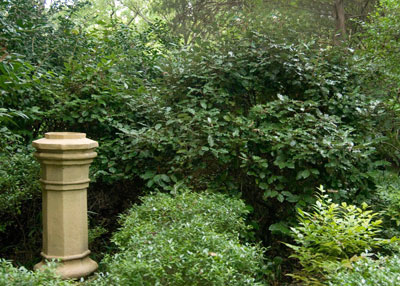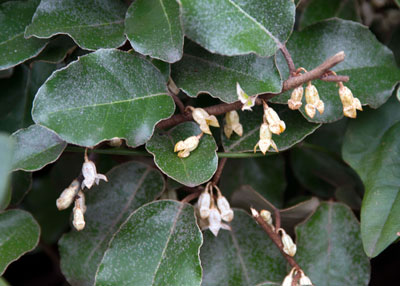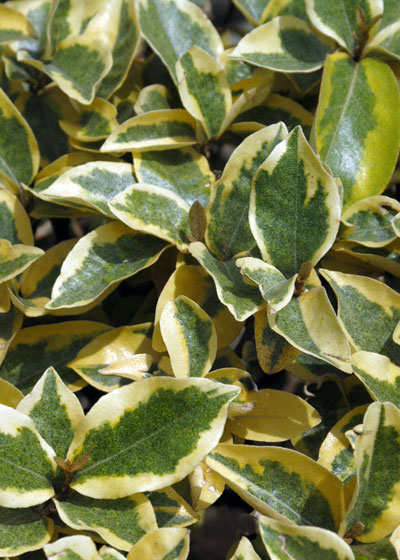Plant of the Week – Elaeagnus: December 19, 2019
Have you noticed a heavenly scent out in the landscape these past couple of weeks? Odds are it was elaeagnus, otherwise known as “fruitland silverberry,” although it’s never called that.
Since I’ve had six or eight calls and questions asking for help in tracking down the source of the aroma, I thought I’d write about it here.

If all of our landscaping shrubs could be this dependable. Elaeagnus grows in a wide assortment of soils. It’s heatproof, and it’s evergreen. Well, kind of green. Actually, it has the gray-green foliage that so many people like in their landscapes. It’s not quite as gray as Texas sage (but a lot more durable) and not nearly as deep green as hollies or junipers.
Grow elaeagnus where you need a large, assertive shrub. Don’t plan on shearing it into some regular (i.e., square) form, because it will rebel with long shoots that you’ll have to remove one by one. Indeed, plant it where it can grow to be 5 or 6 ft. tall and 6 to 8 ft. wide.
Give elaeagnus full or nearly full sun. The better you can water and feed it, the more quickly it will grow and fill in. You may need to do a little reshaping of it each spring, after its burst of new growth, but nothing on a regular basis. It does throw out “fishing poles” of new shoots that can extend a couple of feet beyond the main canopy of the plants’ foliage, but those are easily removed with lopping shears.
It’s normal for elaeagnus leaves to have cinnamon-colored specks on their silvery backsides. Those confuse some gardeners who think that they’re spider mites. They’re actually a normal part of the leaf tissue. If, however, you begin to see tan mottling on the top surfaces of the leaves, lace bugs may be visiting your plant. They’re about the only insect that causes any concern, and a systemic insecticide should make quick work of them if you apply it immediately.

Now as for the flowers (since they’re the reason we called this meeting), very few plants have blooms that are any less obvious. And, that’s OK, because these flowers aren’t much to look at. Funny, isn’t it, that some of the ugliest flowers in Texas so fill the air with delicious fragrance – and at a season when you’re really not set up to expect it.
Those little flowers do produce fruit. It ripens in the spring, and it’s a food source for birds. Each little fruit is about 3/4-inch long, and each is almost completely filled with one single large seed. Between that seed and the leathery skin on the outside of the fruit, there is a blood-red pulp that’s puckery until it ripens, then sweet and modestly consumable (as judged by the lady who called my radio program this past weekend and me).
There are several other species and varieties of elaeagnus, all much less common than this standard one. The rank-growing windbreak tree called Russian olive is actually an elaeagnus (E. angustifolia). It, too, has gray leaves, but it’s too large and erratic for most urban landscapes.

You’ll find several variegated selections of the standard elaeagnus. They’re all dependable, although they do often revert to green branches scattered through the plants. Unless those green shoots are removed, they will quickly overtake the slower-growing yellow-and-green leaves.
A hybrid selection called Ebbenge’s elaeagnus (Elaeagnus x ebbengei) produces lovely gray-green foliage, but on plants that tend to be slightly more upright. It has the same fragrant fall flowers and the same rugged dependability. If you need a slightly taller screening shrub, this could be just the one.
